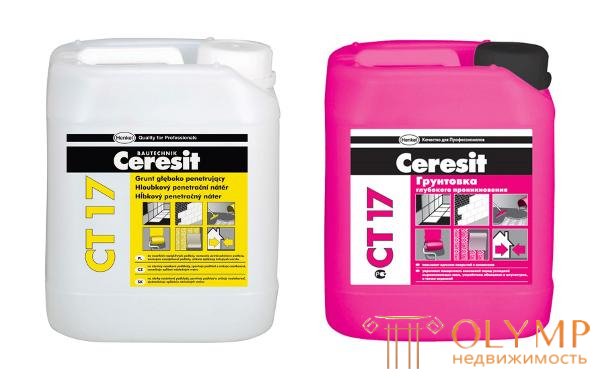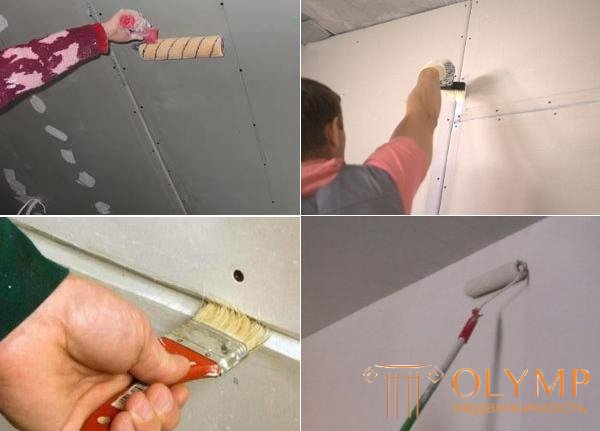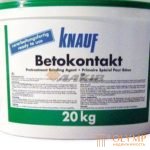
In many cases, when carrying out finishing work is used primer. Primer is used in order to ensure reliable fastening between the finishing and base layers. Many people do not understand whether it is possible to prime drywall, believing that this is some kind of special building material with almost magical properties. It is thanks to the soil that a strong bond between the gypsum plasterboard and the finishing material is formed. Therefore, a primer for drywall is a must.
Content:

Ceresite CT 17 is very often used for the treatment of gypsum plasterboards due to its properties and low cost.
During repair, I want to save as much as possible and not spend money on unnecessary materials. Is it possible to refuse the use of soil without fear for the finished coating? This question must be answered depending on what kind of finishing coating will be used. To understand in which cases the primer is not mandatory, you need to understand why it is needed at all. What are the positive qualities of this material?
When the question arises, what primer plasterboard primer, then you need to decide on what types of this material exist. It is important to choose the material by manufacturer, but still, you need to know about its existing varieties. The main types are as follows:
As you can see, of all the variety can be selected only one primer for hl - acrylic. However, this is not enough for us, because under the wallpaper in the bedroom and under the tile in the bathroom you need to use different acrylic primers. Typically, the manufacturer indicates that its products are best suited for wallpaper or for painting or for other topcoat.

There are many manufacturers of acrylic primers
When choosing a soil you need to pay attention to its color. Usually it is a white or colorless liquid, which after drying can change color. Therefore, before priming drywall, you need to know what will be the finish coating. Under the tile, the color of the soil does not matter, but under the light wallpaper it can be critical.
If it is not critical what color the solution will be, then it is better to choose a noticeable shade. The novice in the process of applying you need to see which areas have already been processed and which need additional processing.
There are a few things that can affect the choice of soil. First you need to decide on the properties of the material. They are:
The positive side is that acrylic blends have most of the above qualities. However, you need to carefully read about all the characteristics on the package.
It is worth paying attention to the cost of primer on drywall per 1m2. This indicator is always indicated by the manufacturer on the package. You should always add about 10% to it to get a real result. It should also be borne in mind that the consumption is indicated on one layer, and it will be necessary to apply the primer in two layers (the second is applied after the first is completely dry). Consumption usually ranges from 100-150 grams per square meter.
| Typical characteristics of acrylic primer | |
| Temperature during operation | from + 5С to + 30С |
| Consumption | 150 ml / sq.m. |
| Coverage area 10 liters in one layer | 65 sq.m. |
| Full drying time at + 20 ° С and 65% air humidity | 6 o'clock |
| Shelf life | 1 year |
In summary, it is recommended to use a plaster-based deep penetration acrylic primer. In most cases, this material will be the perfect solution.
From the video you can learn how to make a primer of deep penetration with your own hands.
The process of priming drywall is not something complicated. It can be easily accommodated in a few simple steps.

Priming is absolutely everything that will interact with the future coating
Not everyone knows whether to drywall plasterboard primer. Although the majority already guesses that such a procedure is necessary. Above has been described the benefits of the soil, so that such questions should not arise.
It is not necessary to coat the entire sheet of drywall with a primer, unless it is completely covered with a putty. Therefore, the primary processing concerns especially the joints. It is best to apply the soil with a brush, which is easy to reach in all places between the sheets. When the primer for drywall under the putty dries, you can apply a finishing putty.
If the reinforcing tape is used, then after its application it is necessary to carry out priming once again. Then the tape is puttied again. The result is a surface made of sheets of drywall, in which all joints are grounded and puttied.
Is it necessary to primer drywall before putty caps screws? After all, putty mixture will fall on the gypsum board. This is not critical, but it is also advisable to use a brush with a primer in such places. Moreover, many screws are screwed in the joints.
If you putty the caps of screws without preliminary treatment with a primer, then nothing terrible will happen. Such actions are not critical.
The next step is puttying the entire surface. And here priming is required. It is best done using a roller. After the entire surface has been treated, you need to give it time to dry, and then apply another layer of soil. There are no special rules here, the main thing is to cover the entire surface with a solution. At the same time, there should be no difficulties with the fact that primer drywall before puttying. It is only necessary to take a deep penetration primer with plaster filler.
Do I need to drywall plasterboard before sticking wallpaper? If you plan to change this wallpaper in the future, the answer is unequivocal - yes. If you do not, then removing the wallpaper will turn into flour, because they will come off with putty or pieces of cardboard (depending on what you pasted them).
Also, the primer for drywall is an excellent tool with which you can hide the putty joints GKL. If this is not done, then the non-uniform color of the base layer will be noticeable under the light wallpaper. That even under dark wallpaper light joints on the background of darker sheets of drywall will appear. If you putty the entire surface and cover with two layers of soil, then you can not be afraid of distortion of the color of the wallpaper.
What primer drywall before sticking wallpaper? more recently, divorced glue was used for this purpose, but now they have begun to give preference to special mixtures. In fact, the same material will be suitable, which was used for puttying in sealing up the joints. Acrylic primer deep penetration well perform its task in the case of wallpaper. If rooms are damp, then anti-fungal additives should be in solution.
 There should be no questions about whether to drywall the plasterboard before laying the tile. Without such a coating there will be insufficient adhesion of the tile to the gypsum board, due to which it can begin to flake off. Moreover, problems may not begin during installation, but some time after the completion of all work. Apply the material in the same way as in all other cases.
There should be no questions about whether to drywall the plasterboard before laying the tile. Without such a coating there will be insufficient adhesion of the tile to the gypsum board, due to which it can begin to flake off. Moreover, problems may not begin during installation, but some time after the completion of all work. Apply the material in the same way as in all other cases.
The primer for drywall under tiles should be compatible with the adhesive composition with which the tile will be fixed.
The primer must be applied twice with an interval so that the first layer dries out. Usually wait from 12 to 24 hours. Although many manufacturers claim that 6 hours should be enough. But it is better not to hurry, because the humidity and temperature are different everywhere. The weight of ceramic tiles is large enough, so you need to take care that it is firmly held. This helps tile adhesive, but without the ground is necessary.
It is not difficult to guess what primer drywall before laying tile. It is worth choosing the same deep penetration acrylic primer with anti-fungal properties. Choosing specific products from different manufacturers you need to make sure that it is suitable for working with ceramic tiles.
Primer for drywall for painting does not have any critical features. It is needed not so much for better adhesion as to protect the GCR. The paint is very wet, so it is undesirable for drywall to absorb this moisture and begin to swell. With a dismissive approach on the sheets may appear bumps and depressions, which will receive their reflection on the paint. Therefore, the primer and paint drywall should go in tandem.
The procedure for applying a primer mixture before painting has no particular differences. The entire surface is covered with this material with a roller.
Что бы оставить комментарий войдите
Комментарии (0)